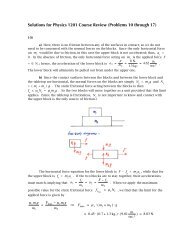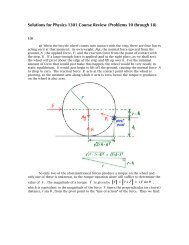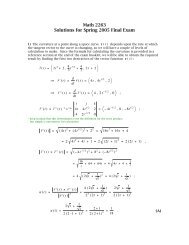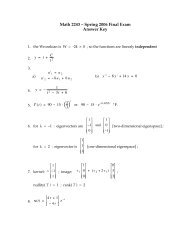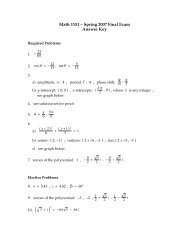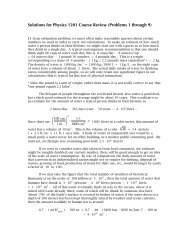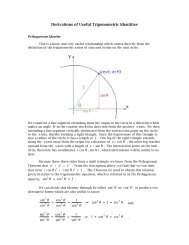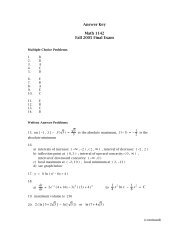Math 2243 Solutions for Fall 2005 Final Exam
Math 2243 Solutions for Fall 2005 Final Exam
Math 2243 Solutions for Fall 2005 Final Exam
You also want an ePaper? Increase the reach of your titles
YUMPU automatically turns print PDFs into web optimized ePapers that Google loves.
<strong>Math</strong> <strong>2243</strong><br />
<strong>Solutions</strong> <strong>for</strong> <strong>Fall</strong> <strong>2005</strong> <strong>Final</strong> <strong>Exam</strong><br />
!<br />
1) We have a first-order linear differential equation of the <strong>for</strong>m y ’ + P ( x ) y = Q ( x ) ,<br />
in this case a rather simple one with P ( x ) = 3 and Q ( x ) = 5 . To solve an equation<br />
of this sort, we first multiply it through by a function I ( x ) called an “integrating<br />
factor”. The property which determines how this function is chosen is that the left-hand<br />
side of the differential equation takes on a <strong>for</strong>m satisfying the Product Rule, making it<br />
simple to integrate and allowing us to obtain the function y :<br />
I ( x ) y ’ + I ( x ) P ( x ) y = I ( x ) Q ( x ) ! [ I ( x ) y ] ’ = I ( x ) Q ( x )<br />
" I ( x ) y = # I ( x ) Q( x ) dx " y =<br />
I ( x ) Q( x ) dx<br />
For this approach to work, we must have I ’ ( x ) = I ( x ) P ( x ) in our equation, since<br />
the Product Rule gives us I ( x ) y ’ + I ’( x ) y = [ I ( x ) y ] ’ . The integrating factor is<br />
thus specified ! by a separable differential equation of its own, leading to<br />
d I<br />
I ( x )<br />
#<br />
I ( x )<br />
= P( x ) dx " ln I ( x ) = # P( x ) dx " I ( x ) = e<br />
The integrating factor <strong>for</strong> our equation is then<br />
here, we can proceed to its general solution:<br />
.<br />
# P( x ) dx<br />
.<br />
I ( x ) = e 3 dx " = e 3x . From<br />
e 3x y ’ + 3 e 3x y = 5 e 3x ! [ e 3x y ] ’ = 5 e 3x<br />
!<br />
" e 3x y = # 5 e 3x dx = 5 3 e3x + C " y = 5 3 + C e$3x .<br />
[Note that while the indefinite integral determining the integrating factor does not take<br />
on an “arbitrary constant, the final indefinite integral <strong>for</strong> the general solution of the<br />
differential ! equation must do so.]<br />
!<br />
2) A frequently-applied technique <strong>for</strong> analyzing a second-order differential equation is<br />
to create a second variable, say, v = y ’ , which is the derivative of the function to be<br />
solved <strong>for</strong>. This allows us to trans<strong>for</strong>m the single equation into a system of two firstorder<br />
differential equations. In this problem, we thus have<br />
y'' " y y' + 2 y' " y 2 + 5 y = 0 # v = y' , v' " y v + 2 v " y 2 + 5 y = 0<br />
or y' = v , v' = ( y " 2) v + ( y " 5) y .!<br />
!<br />
The derivative of y is zero <strong>for</strong> any constant value of v , a statement which doesn’t give<br />
us a lot of in<strong>for</strong>mation about the critical points of this system. However, if v is set to<br />
zero, then the derivative of v becomes zero where the second term of the equation is<br />
!<br />
equal to zero, at y = 0 and y = 5 . (For v ! 0 , the first term can only become zero<br />
at y = 2 , which fails to make the second term equal to zero as well.)
Consequently, the system has two equilibrium points, located at ( 0, 0 ) and<br />
( 5, 0 ) in a v versus y graph. In order to analyze the stability of the system at these<br />
points, we need to evaluate the Jacobian matrix <strong>for</strong> the system at those positions:<br />
!<br />
y' = f (v, y ) = v , v' = g(v, y ) = ( y " 2) v + ( y " 5) y !<br />
!<br />
! "<br />
# f y ( y 0 , v 0 ) f v ( y 0 , v 0 ) & # 0 1 &<br />
J ( y 0 , v 0 ) = %<br />
( = %<br />
(<br />
$ g y ( y 0 , v 0 ) g v ( y 0 , v 0 ) ' $ v + 2y ) 5 y ) 2 '<br />
( y 0 , v 0 )<br />
.<br />
# 0 1 &<br />
So at ( 0, 0 ) , we have J (0 , 0) = % (!!, corresponding to the<br />
!<br />
$ " 5 " 2 '<br />
linearization y' = v , v' = " 5 y " 2 v! , which has the eigenvalue equation<br />
( –" ) ( #2 – " ) + 5 = " 2 + 2" + 5 = 0 . The eigenvalues are thus<br />
!<br />
!<br />
" = #2 ± 22 # 4 $1 $ 5<br />
2 $ 1<br />
=<br />
#2 ± #16<br />
2<br />
= #1 ± 2i .<br />
Since these are complex, the flow field circulates around the origin, but the negative real<br />
part indicates that the flow is drawn toward that point [the associated solution<br />
functions ! have the <strong>for</strong>m e "t (cos 2t + sin 2t ) ]. Hence the equilibrium point at the<br />
origin is a stable spiral (also called a “spiral sink”).<br />
!<br />
the flow field in the neighborhood of the origin<br />
(continued)
!<br />
"<br />
At the other equilibrium point, ( 5, 0 ) , we have J (0 , 0) = 0 1 %<br />
$ '!!, which<br />
# 5 3&<br />
corresponds to the linearization [u + 5]' = v , v' = ([u + 5] " 2) v + ([u + 5] " 5)[u + 5]<br />
" u ' = v , v' = 5u + 3v , where we have applied a shifted variable u = y + 5 to make<br />
( 5, 0 ) the center of the flow field. The eigenvalue equation here is ( –" ) ( 3 – " ) # 5<br />
!<br />
= " 2 # 3" # 5 = 0 , giving us the eigenvalues<br />
!<br />
" = #[ #3] ± [ #3]2 # 4 $1 $[ #5]<br />
2 $ 1<br />
= 3 ± 29<br />
2<br />
.<br />
Since "29 > 3 , we have one positive and one negative eigenvalue; this means that the<br />
flow field moves toward ( 5, 0 ) , generally along the direction of the eigenvector <strong>for</strong> the<br />
negative eigenvalue, ! and away from theat point, generally along the direction of the<br />
eigenvector <strong>for</strong> the positive eigenvalue (we do not need to find those eigenvectors here).<br />
Eigenvalues of opposite signs thus are the indicators of a “saddle point”.<br />
the flow field in the neighborhood of ( 5, 0 ) ,<br />
shifted to the center of coordinates<br />
The flow field of the complete non-linear system is shown in the graph below.<br />
(continued)
the actual non-linear flow field <strong>for</strong> the system<br />
!<br />
3) It will be helpful to start by getting a sense of how the given linear trans<strong>for</strong>mation in<br />
this Problem works. The trans<strong>for</strong>mation T ( v ) “maps” a 3 $ 1 matrix in R 3 into a<br />
2 $ 1 matrix in R 2 , according to T (v ) = 2 2 2<br />
" v<br />
" % 1<br />
%<br />
$ ' "<br />
$ ' v<br />
# 2 3 2 2<br />
&<br />
$ '<br />
= 2v 1 + 2v 2 + 2v 3<br />
%<br />
$<br />
' .<br />
# 2v<br />
# $ v 3 &'<br />
1 + 3v 2 + 2v 3 &<br />
The kernel (or “null space”) of this trans<strong>for</strong>mation is the set of 3 x 1 matrices<br />
"<br />
<strong>for</strong> which T (v ) = 0 = 0 %<br />
$ ' , so it is described by the system of linear equations<br />
# 0<br />
!&<br />
2v 1 + 2v 2 + 2v 3 = 0<br />
!!. If we subtract the first equation from the second either<br />
2v 1 + 3v 2 + 2v 3 = 0<br />
algebraically or by row-reduction of the coefficient matrix <strong>for</strong> T ( v ) , we find that<br />
!<br />
v 2<br />
= 0 . Inserting this into either of the system equations then leads us to v 1<br />
= #v 3<br />
.<br />
The system of equations cannot be solved any further than this, so this last equation<br />
tells us that there is one “free variable” in the system; we may choose this to be either v 1<br />
or v 3<br />
. If we decide to assign an arbitrary value to v 1<br />
, it is customary to declare that<br />
# 1 &<br />
% (<br />
number to be 1 . This allows us to construct the solution vector<br />
%<br />
0<br />
(!!; but any scalar<br />
$ %"1'(<br />
multiple of this vector will also serve as a solution to our system of equation. Hence, the<br />
) # 1 &<br />
-<br />
+ % (<br />
+<br />
!<br />
kernel of this trans<strong>for</strong>mation is the set ker(T )* = * a<br />
%<br />
0<br />
(<br />
, a being any real number.<br />
+<br />
, $ %"1'(<br />
+ .<br />
/<br />
* also called Null ( T ) (continued)<br />
!
Since all of the vectors in the kernel have the same direction vector, they can be<br />
thought of as all falling on a single line in three-dimensional space. The vector subspace<br />
so described is thus one-dimensional, meaning that the dimension of ker ( T ) (also<br />
referred to as “the nullity” of T ) is dim(kernel) = 1 . We have a theorem stating that the<br />
rank of T (or the dimension of the range space of T ) is given by rank ( T ) + dim(kernel)<br />
= n , with n being the dimension of the vector space that T operates within. The<br />
trans<strong>for</strong>mation maps vectors in R 3 , so we have rank ( T ) + dim(kernel) = 3 !<br />
rank ( T ) = 3 # 1 = 2 . We can also see this by considering the mapping by T to a<br />
" A %<br />
non-zero vector T (v ) = $ ' , with A and B not both permitted to be zero. We now<br />
# B &<br />
have v 2<br />
= B – A , but still with v 1<br />
= #v 3<br />
. So the solutions of the linear system of<br />
# a &<br />
% (<br />
equations, which constitute the range of T , have the <strong>for</strong>m b = B " A<br />
!<br />
% (!!. Because a and<br />
$ % "a '(<br />
b are not related to one another, these vectors lie in a particular plane in R 3<br />
; hence,<br />
rank( T ) = 2 . (Evidently, not every vector in R 3 is in the range of T ).<br />
!<br />
# 1 1 &<br />
4) The system of two linear differential equations, x' = %<br />
$ "2 4 '<br />
( x + # 1 &<br />
%<br />
$ 3 ( , is<br />
'<br />
non-homongeneous, so we must solve <strong>for</strong> the solution functions in two parts, one being<br />
# 1 1 &<br />
the “complementary solution”, x C<br />
, to the homogenous system x' = % ( x and<br />
"2 4<br />
!<br />
$ '<br />
the “particular solution”, x P<br />
, which takes the non-homogeneous term into account.<br />
The complementary solution functions are found by first determining the<br />
eigenvalues and corresponding eigenvectors <strong>for</strong> the coefficient ! matrix in the system. By<br />
1 " # 1<br />
evaluating the determinant<br />
"2<br />
!!, we can set up the eigenvalue equation<br />
4 " #<br />
( 1 – " ) ( 4 – " ) # ( #2 ) = 0 ! " 2 # 5" + 6 = 0 ! ( " # 2 ) ( " – 3 ) = 0 . So the<br />
eigenvalues of the system are " = 2 and " = 3 , which have the corresponding<br />
eigenvectors<br />
" = 2 :<br />
!<br />
$ 1 # 2 1 ' $<br />
&<br />
) &<br />
% #2 4 # 2 ( %<br />
v 1<br />
v 2<br />
'<br />
(<br />
) = $ 0 '<br />
&<br />
% 0 ) * # v 1 + v 2 = 0<br />
( # 2v 1 + 2v 2 = 0 * v 1 = v 2 ,<br />
!<br />
!<br />
so we have one free variable and may chose v 1<br />
= 1 , giving us the<br />
" 1 %<br />
eigenvector $ '!!;!<br />
# 1 &<br />
$ 1 # 3 1 ' $<br />
" = 3 :<br />
!<br />
&<br />
) &<br />
% #2 4 # 3(<br />
%<br />
v 1<br />
v 2<br />
'<br />
(<br />
) = $ 0 '<br />
&<br />
% 0 ) * # 2 v 1 + v 2 = 0<br />
( # 2v 1 + v 2 = 0 * 2 v 1 = v 2 ,<br />
!<br />
leading to the eigenvector<br />
" 1 %<br />
$ '!!.<br />
# 2 &<br />
(continued)<br />
!
The eigenvalues tells us that the exponential solution functions are x 1<br />
x 2<br />
= e 3t , which leads to the complementary solution<br />
= e 2t and<br />
"<br />
x c = x 1%<br />
" 1%<br />
$ ' = c 1 $ ' e 2t " 1 %<br />
+ c<br />
# & # 1<br />
2 $ ' e 3t<br />
& # 2 &<br />
x 2<br />
or<br />
" c 1 e 2t + c 2 e 3t %<br />
$<br />
# c 1 e 2t + 2c 2 e 3t ' .<br />
&<br />
The non-homogeneous term is a column matrix with constant entries, so the trial<br />
functions <strong>for</strong> the particular solution will also be constants (these would correspond to<br />
an eigenvalue ! of zero, since e 0 · t = 1 , so there is no duplication of terms in the<br />
"<br />
complementary solution). We will then insert x p = A %<br />
$ '!!into our non-homogeneous<br />
# B&<br />
system of differential equations to find<br />
d<br />
dt<br />
" A%<br />
$ ' =<br />
# B&<br />
" 1 1 %"<br />
$<br />
(2 4<br />
!<br />
# &<br />
' A %<br />
$<br />
# B &<br />
' + " 1 %<br />
$<br />
# 3 &<br />
' ) " 0 %<br />
$<br />
# 0 ' =<br />
&<br />
" 1 1 %"<br />
$<br />
# (2 4 &<br />
' A %<br />
$<br />
# B &<br />
' + " 1 % "<br />
$<br />
# 3 ' ) 1 1 %"<br />
$<br />
& # (2 4 &<br />
' A % "<br />
$<br />
# B ' = (1 %<br />
$ ' .<br />
& # (3 &<br />
We may now use whichever method we like <strong>for</strong> solving a system of linear algebraic<br />
!<br />
equations (substitution, row-reduction, etc.) to calculate that<br />
A = " 1 6 and B = " 5 6 .<br />
Thus, the general solution <strong>for</strong> our system of differential equations is<br />
" 1%<br />
!<br />
x = x c + x p = c 1 $ ' e 2t " 1 % "<br />
+ c<br />
# 1<br />
2 $ ' e 3t + ( 1 %<br />
$ 6 '<br />
& # 2 & #<br />
$<br />
&<br />
'<br />
( 5 6<br />
or<br />
"<br />
c 1 e 2t + c 2 e 3t ( 1 %<br />
$<br />
6<br />
#<br />
$ c 1 e 2t + 2c 2 e 3t ( 5 '<br />
6 &<br />
'<br />
.<br />
!<br />
d<br />
dt<br />
We can place this into the original system to verify the solution:<br />
#<br />
c 1 e 2t + c 2 e 3t " 1 &<br />
%<br />
6<br />
$<br />
% c 1 e 2t + 2c 2 e 3t " 5 (<br />
6 '<br />
( = # 2c 1 e 2t + 3c 2 e 3t &<br />
%<br />
$ 2c 1 e 2t + 6c 2 e 3t (<br />
'<br />
!<br />
=<br />
# 1 1 &<br />
% (<br />
$ "2 4 '<br />
#<br />
c 1 e 2t + c 2 e 3t " 1 &<br />
%<br />
6<br />
$<br />
% c 1 e 2t + 2c 2 e 3t " 5 (<br />
6 '<br />
( + # 1 &<br />
% (<br />
$ 3 '<br />
!<br />
!<br />
=<br />
=<br />
#<br />
(c 1 e 2t + c 2 e 3t " 1 6 ) + (c 1 e 2t + 2c 2 e 3t " 5 6 ) + 1 &<br />
%<br />
("2) (c 1 e 2t + c 2 e 3t " 1 6 ) + 4 (c 1 e 2t + 2c 2 e 3t " 5 (<br />
$<br />
%<br />
6 ) + 3 '<br />
(<br />
#<br />
(c 1 + c 1 ) e 2t + (c 2 + 2c 2 ) e 3t " 1 " 5 6 6 + 1 &<br />
%<br />
(" 2c 1 + 4 c 1 ) e 2t + (" 2c 2 + 8c 2 ) e 3t + 2 6 " 20 (<br />
$<br />
%<br />
6 + 3 '<br />
( = # 2c 1 e 2t + 3c 2 e 3t &<br />
%<br />
$ 2c 1 e 2t + 6c 2 e 3t ( .! !<br />
'<br />
!
5) To test <strong>for</strong> the linear independence of three functions on an interval, we evaluate the<br />
f g h<br />
Wronskian determinant<br />
W ( f , g, h ) =<br />
f ' g' h'<br />
f '' g'' h''<br />
; if this determinant is zero<br />
everywhere on the interval, then there is linearly dependence among this set of<br />
functions. For the functions given in this Problem, we find that the Wronskian is<br />
W =<br />
3t + 15<br />
!<br />
3t " 15 te t<br />
3 3 e t + te t = (t + 1)e t<br />
0 0 e t + (t + 1) e t = (t + 2)e t<br />
!<br />
= (t + 2)e t 3t + 15 3t " 15<br />
3 3<br />
= [ (9t + 45) " (9t " 45) ] (t + 2)e t = 90 (t + 2)e t .!<br />
This determinant is zero only at the single value t = #2 , so these three functions are<br />
linearly independent on the real numbers [the interval ( #% , % ) ].<br />
!<br />
The function t is in the span of this set S of functions if there is some linear<br />
combination A f + B g + C h = t , with A , B , and C are real numbers. With<br />
A ( 3t + 15 ) + B ( 3t # 15 ) + C ( t e t ) = t , it is clear that C must be zero, since the<br />
function on the right-hand side has no exponential factor. However, we still require that<br />
( 3A + 3B ) t + ( 15A – 15B ) = t . As there is no constant term on the right-hand side,<br />
we have A = B . It must then be the case that 3A + 3B = 6A = 1<br />
" A = 1 6 = B .<br />
So there does exist a linear combination of the three given functions which can produce<br />
the function t , which means that this function is in the span of the set S .<br />
!<br />
6) For a second-order linear differential equation with constant coefficients,<br />
a y ’’ + b y ’ + c y = 0 , there are two solution functions having a factor e rx . The<br />
constants in the exponents of these functions are the roots of the characteristic<br />
equation ar 2 + br + c = 0 ; if the roots have distinct values r 1<br />
and r 2<br />
, then the<br />
solution functions will simply be e r 1 x<br />
and e r 2 x . The general solution to the<br />
homogenous equation is then the linear combination<br />
y c = c 1 e r 1 x + c 2 e r 2 x .<br />
For our differential equation, y ’’ + 4 y ’ # 9 y = 0 , we have the characteristic<br />
!<br />
equation r 2 + 4r # 9 = 0 with the roots<br />
!<br />
r 1,2 = " 4 ± 4 2 " 4 #1 # (" 9)<br />
2 # 1<br />
= " 4 ± 52<br />
2<br />
= " 2 ± 13 .<br />
The complementary solution is thus y c = c 1 e ( "2 " 13 )x + c 2 e ( "2 + 13 )x ; since the<br />
differential equation is homogeneous, this is the complete general solution.<br />
!<br />
!
!<br />
7) We have a single tank initially containing 10 gallons of pure water. We wish to track<br />
the mass of salt, y ( t ) , found in the tank at later times, given that brine with a<br />
concentration of c in<br />
= 5 lb./gallon* is being poured into this tank at the rate<br />
" dV %<br />
$ ' = 2 gallon/min. and, assuming thorough mixing of the contents of the tank, the<br />
# d t &<br />
in<br />
" dV %<br />
resulting solution is being drained at $ ' = 4 gallon/min. (Since the water in the<br />
# d t &<br />
out<br />
tank is initially pure, we have y ( 0 ) = 0 ) .<br />
!<br />
!<br />
* just go with it, though I’d like to see someone get five pounds of salt to dissolve in one<br />
gallon of water…<br />
!<br />
We will need to write a “mass flow rate” equation describing what is happening<br />
" dy % "<br />
within the tank: generically, this is $ ' = dy % "<br />
$ ' ( dy %<br />
$ ' . The mass of salt<br />
# dt & dt<br />
net<br />
# & dt<br />
in<br />
# &<br />
out<br />
being carried by a solution is given by y = c · V , where c is the salt concentration of<br />
the solution and V is the volume under consideration. Since this is a product of two<br />
" dy % "<br />
quantities, the time derivative ! is properly given by $ ' =<br />
dc % " dV %<br />
$ ' ( V + c ( $ ' . Thus,<br />
# dt & # dt & # dt &<br />
the net rate of change <strong>for</strong> the mass of salt in the tank is also given by<br />
" dy % "<br />
$ ' = dc %<br />
" dV %<br />
$ ' ( V + c(t ) ( $ ' .<br />
# dt & dt<br />
net<br />
# &<br />
# dt &<br />
net<br />
!<br />
For the brine being sent into the tank, the concentration of salt is constant, so we<br />
" dy % " dV %<br />
write $ ' = c<br />
# dt in ( $ ' . The solution being drained from the tank, however, has<br />
& dt<br />
in<br />
# &<br />
in<br />
the salt concentration found within the tank at any given moment, so c out<br />
= y ( t ) / V ,<br />
with V here being the volume of solution presently in the tank; hence, we write (<strong>for</strong> the<br />
" dy % " dV %<br />
moment) $ ' = c<br />
# dt out ( $ ' = y(t )<br />
&<br />
dt<br />
out<br />
# &<br />
out<br />
V<br />
( " dV %<br />
$ ' .<br />
# dt &<br />
out<br />
Because the rates at which solution is being added to or removed from the tank<br />
do not match, the volume of liquid in the tank is itself a function of time. We can write<br />
a !“volume flow rate” equation, analogous to the mass flow equation, which is<br />
"<br />
$<br />
#<br />
dV<br />
dt<br />
%<br />
'<br />
&<br />
net<br />
"<br />
= dV %<br />
$ '<br />
# dt &<br />
in<br />
"<br />
( dV %<br />
$ '<br />
# dt &<br />
out<br />
= 2 gal.<br />
min.<br />
( 4 gal.<br />
min.<br />
= ( 2 gal.<br />
min.<br />
.<br />
With an initial volume in the tank V ( 0 ) = 10 gallons, we can easily find the function<br />
describing the volume at later times as V ( t ) = 10 # 2t gallons.<br />
!<br />
We can now develop the complete mass flow rate differential equation which we<br />
will need to solve under the initial conditions given. The rate at which salt is leaving the<br />
" dy %<br />
tank is $ ' = y(t )<br />
# dt &<br />
out<br />
V (t ) ( " dV % y(t )<br />
$ ' =<br />
# dt &<br />
out<br />
10 ) 2t ( 4 . This gives us the mass flow equation<br />
(continued)<br />
!
" dy %<br />
$ '<br />
# dt &<br />
net<br />
"<br />
= dc %<br />
" dV<br />
$ ' ( V (t ) + c(t ) ( $<br />
# dt &<br />
# dt<br />
%<br />
'<br />
&<br />
net<br />
"<br />
= dc %<br />
*"<br />
dV<br />
$ ' ( V (t ) + c(t ) (,<br />
$<br />
# dt &<br />
+ # dt<br />
%<br />
'<br />
&<br />
in<br />
"<br />
) dV %<br />
$ '<br />
# dt &<br />
out<br />
-<br />
/<br />
.<br />
!<br />
"<br />
= dy %<br />
$ '<br />
# dt &<br />
in<br />
"<br />
( dy %<br />
$ '<br />
# dt &<br />
out<br />
" dV<br />
= c in ) $<br />
# dt<br />
%<br />
'<br />
&<br />
in<br />
( y(t )<br />
V (t ) ) " dV %<br />
$ '<br />
# dt &<br />
out<br />
!!.<br />
At this point, we can go one of two ways with this equation. If we choose to<br />
express the differential equation in terms of the mass of salt in the tank, then we need<br />
the equation ! <strong>for</strong> the net rate of mass flow,<br />
dy<br />
dt<br />
# dV<br />
= c in " %<br />
$ dt<br />
&<br />
(<br />
'<br />
in<br />
) y(t )<br />
V (t ) " # dV &<br />
% (<br />
$ dt '<br />
out<br />
= (5 " 2) )<br />
y(t )<br />
10 ) 2t " 4 ,<br />
!<br />
which is a first-order linear differential equation, but is not separable. We could instead<br />
produce a differential equation <strong>for</strong> the concentration of salt in the tank,<br />
!<br />
" dc %<br />
*"<br />
dV % "<br />
$ ' ( V (t ) + c(t ) ( $ ' ) dV % - " dV % " dV %<br />
, $ ' / = c<br />
# dt &<br />
+ # dt & dt<br />
in ( $ ' ) c(t ) ( $ ' !<br />
in<br />
# &<br />
out . # dt & # dt &<br />
in<br />
out<br />
!<br />
#<br />
! " dc &<br />
# dV & #<br />
% ( ) V (t ) = [ c<br />
$ dt<br />
in * c(t ) ]) % ( " dc &<br />
% ( ) (10 * 2t ) = [ 5 * c(t ) ]) 2 ,<br />
'<br />
$ dt ' $ dt '<br />
in<br />
which is a separable equation; after solving <strong>for</strong> c ( t ) , we would then find the mass<br />
function <strong>for</strong> the salt from y ( t ) = c ( t ) · V ( t ) .<br />
!<br />
The differential equation <strong>for</strong> mass can be arranged into the <strong>for</strong>m upon which we<br />
can apply an integrating factor by multiplication:<br />
! !<br />
!!<br />
!<br />
!<br />
dy<br />
dt<br />
= (5 " 2) #<br />
y(t )<br />
10 # 2t " 4 $ dy<br />
dt<br />
P( t )dt<br />
I ( x ) = e " = e<br />
" (10 # 2t ) #2 $ dy<br />
dt<br />
"<br />
$<br />
&<br />
%<br />
+<br />
'<br />
(<br />
4<br />
) dt<br />
10 # 2t<br />
% 4 (<br />
' *<br />
& 10 # 2t<br />
14 243<br />
)<br />
P( t )<br />
y = 10 { ; !<br />
Q( t )<br />
= e #2 ln (10 # 2t ) = (10 # 2t ) #2 ;!<br />
%<br />
+ (10 # 2t ) #2 4 (<br />
$ ' * y = 10 (10 # 2t ) #2<br />
& 10 # 2t )<br />
multiplying through by I ( x )<br />
!<br />
" (10 # 2t ) #2 $ dy<br />
dt<br />
+<br />
%<br />
4<br />
(<br />
'<br />
&(10 # 2t ) 3 * y = 10 (10 # 2t ) #2<br />
)<br />
" d<br />
!<br />
dt<br />
* $<br />
1<br />
' .<br />
+ &<br />
%(10 # 2t ) 2 ) y /<br />
,-<br />
( 0 - = 10 (10 # 2t )#2 "<br />
applying the Product Rule<br />
$ 1 '<br />
&<br />
% (10 # 2t ) 2 ) y = 10 1 (10 # 2t ) #2 dt<br />
(<br />
integrating both sides of the equation and<br />
applying the Fundamental Theorem of Calculus<br />
!
$ 1 '<br />
" &<br />
% (10 # 2t ) 2 ) y = 5 (10 # 2t ) #1 + C " y = 5 (10 # 2t ) + C (10 # 2t ) 2 .<br />
(<br />
The initially pure water in the tank requires that y(0) = 5 (10 " 2 # 0) + C (10 " 2 # 0) 2 !<br />
!<br />
!<br />
= 50 + C " 10 2 = 0 # C = $ 1 !!"!!The function <strong>for</strong> the mass of salt in the tank at<br />
2<br />
time t is there<strong>for</strong>e<br />
y = 5 (10 " 2t ) " 1 ! 2 (10 " 2t )2 = 10 t " 2 t 2 .<br />
The differential equation <strong>for</strong> salt concentration in the tank can be separated as<br />
dc<br />
5 " c<br />
=<br />
! 2<br />
10 " 2t dt # dc<br />
$ =<br />
5 " c<br />
dt<br />
$ # " ln 5 " c = " ln 5 " t + C ;<br />
5 " t<br />
since the water in the tank is initially pure, we require<br />
!<br />
!<br />
! !<br />
c(0) = 0 " # ln 5 # 0 = # ln 5 # 0 + C " C = 0!<br />
" # ln 5 # c = # ln 5 # t " 5 # c = 5 # t " c(t ) = t .<br />
!<br />
The function <strong>for</strong> the mass of salt in the tank is then obtained from y ( t ) = c ( t ) · V ( t )<br />
= t ( 10 # 2t ) = 10 t # 2 t 2 , as we found above.<br />
!<br />
Since the tank is being drained faster than it is being filled, the volume of<br />
solution in the tank will fall to zero in a finite amount of time; in fact, this occurs at<br />
V ( t ) = 10 # 2t = 0 ! t = 5 minutes . From this, we see that the mass of salt in<br />
the tank will also be driven to zero at that time, that is, y ( 5 ) = 0 , as we would<br />
expect. Perhaps surprisingly, the concentration of salt is c ( 5 ) = 5 lb./gallon then.<br />
The interpretation of this result is that just as the tank is about to be emptied<br />
completely, the liquid remaining in the tank is just about entirely from the brine being<br />
pumped into it, so the concentration of salt in the tank approaches the concentration of<br />
the entering brine in the limit as V ( t ) approaches zero.<br />
8) We have a difference of terms in the exponent of the exponential function in the<br />
given differential equation, so it will be helpful to apply the properties of exponents in<br />
dy<br />
order to simplify this expression: = e 3t " y = e 3t # e "y = e 3t<br />
dt<br />
e y .<br />
We can now see from this result that the differential equation is separable, allowing us<br />
to proceed to a general solution:<br />
" e y dy = e 3t dt # e y dy<br />
!<br />
$ = $ e 3t dt # e y = 1 3 e3t + C .<br />
it is convenient at this point to apply the initial condition y ( 0 ) = 0 to find<br />
!<br />
e 0 = 1 3 e3 " 0 + C # 1 = 1 3 "1 + C # C = 2 3 . !<br />
It remains to solve the equation we’ve produced <strong>for</strong> the specific solution <strong>for</strong> y ( t ) :<br />
!<br />
" e y = 1 3 e3t + 2 3 # y(t ) = ln $ 2 3 + 1 '<br />
&<br />
% 3 e3t ) .!<br />
(<br />
!
!<br />
9) In order <strong>for</strong> a set to <strong>for</strong>m a vector space, it must be the case that any linear<br />
combination of vectors in the set must also be a member of that set. The specification<br />
" x %<br />
<strong>for</strong> the set of two-dimensional vectors $ ' in this Problem is that the product of the<br />
# y &<br />
" a %<br />
components is zero, that is, x y = 0 . The vectors in this set all have the <strong>for</strong>ms $ '<br />
# 0 &<br />
" 0 %<br />
!<br />
or $ ' , where a and b are any real numbers. But the sum of two such vectors is<br />
# b &<br />
" a % "<br />
!<br />
$ ' +<br />
0 % "<br />
$ ' =<br />
a %<br />
$ ' , which generally will have a · b ! 0 . Hence, this set is not closed<br />
# 0 & # b & # b &<br />
under addition and thus cannot <strong>for</strong>m a vector subspace of R 2 .<br />
!<br />
10) We are given the first-order non-homogeneous linear differential equation with an<br />
initial condition, t y ’ # y = t 2 cos t , with y ( & ) = 3 . The equation can be written<br />
in a <strong>for</strong>m <strong>for</strong> which we can determine an integrating factor (as discussed in Problem 1 ) :<br />
" y' # 1 { t<br />
y = t 1 cos 23 t<br />
P( t ) Q( t )<br />
divide through by t<br />
P( t ) dt<br />
; I (t ) = e$ = e $ # 1 dt t<br />
= e #ln t = 1 t<br />
;<br />
!<br />
" 1 t y' # 1<br />
t y = cos t $ %<br />
'<br />
1 2 & t y (<br />
* ' = cos t $ 1 )<br />
t<br />
multiply through by I ( x )<br />
y = + cos t dt<br />
!<br />
!<br />
" 1 t<br />
y = sin t + C " y = t sin t + C t .<br />
Having found the general solution <strong>for</strong> the differential equation, we can now apply the<br />
initial condition, in order to determine the specific solution which satisfies it:<br />
Hence, the specific solution to our initial-value problem is<br />
" C = 3 # .<br />
y ( & ) = & sin & + C · & = & · 0 + C · & = 3<br />
#<br />
y = t sin t + % 3 &<br />
( t .<br />
$ " '<br />
!<br />
11) The procedure <strong>for</strong> solving a system of first-order linear homogeneous differential<br />
equations with constant coefficients is reminiscent of what is done <strong>for</strong> a single equation;<br />
however, instead of writing a characteristic equation, ! we must instead construct an<br />
eigenvalue equation. We wish to solve the matrix equation Ax = "x , which is<br />
accomplished by finding where the determinant of A – "I = 0 :<br />
7 " # 1 0<br />
"3 3 " # 2<br />
0 0 1 " #<br />
= (1 " # ) 7 " # 1<br />
"3 3 " #<br />
= (1 " # ) [ (7 " # ) (3 " # ) " (" 3) ]<br />
!<br />
= (1 " # ) (# 2 " 10 # + 24 ) = (1 " # ) (# " 4 ) (# " 6) = 0 $ # = 1 , 4 , or 6 .!<br />
(continued)<br />
!
We must next work out the eigenvectors corresponding to each of these<br />
eigenvalues:<br />
" = 1 :<br />
$ 7 # 1 1 0 '<br />
&<br />
)<br />
&<br />
#3 3 # 1 2<br />
)<br />
%&<br />
0 0 1 # 1 ()<br />
$<br />
&<br />
&<br />
%&<br />
x 1<br />
x 2<br />
x 3<br />
'<br />
)<br />
)<br />
()<br />
=<br />
$ 6 1 0 '<br />
& )<br />
&<br />
#3 2 2<br />
)<br />
%&<br />
0 0 0 ()<br />
$<br />
&<br />
&<br />
%&<br />
x 1<br />
x 2<br />
x 3<br />
'<br />
)<br />
)<br />
()<br />
=<br />
$ 0 '<br />
& )<br />
&<br />
0<br />
)<br />
%&<br />
0 ()<br />
*<br />
6 x 1 + x 2 = 0<br />
#3 x 1 + 2x 2 + 2x 3 = 0<br />
one free variable<br />
!<br />
"<br />
# 6 x 1 = x 2<br />
3<br />
2 x 1 # x 2 = x 3<br />
set x 1 = 1<br />
"<br />
$<br />
&<br />
&<br />
&<br />
%<br />
1<br />
# 6<br />
15<br />
2<br />
'<br />
)<br />
)<br />
)<br />
(<br />
$ 2 '<br />
& )<br />
*<br />
&<br />
#12<br />
)<br />
;<br />
%&<br />
15 ()<br />
eliminating fractions<br />
!<br />
!<br />
" = 4 :<br />
$ 7 # 4 1 0 ' $<br />
&<br />
) &<br />
&<br />
#3 3 # 4 2<br />
) &<br />
%&<br />
0 0 1 # 4 ()<br />
%&<br />
"<br />
# 3 x 1 = x 2<br />
set x 1 = 1<br />
x 3 = 0<br />
"<br />
x 1<br />
x 2<br />
x 3<br />
'<br />
)<br />
)<br />
=<br />
()<br />
$ 1 '<br />
& )<br />
&<br />
# 3<br />
)<br />
%&<br />
0 ()<br />
$ 3 1 0 ' $<br />
&<br />
) &<br />
&<br />
#3 #1 2<br />
) &<br />
%&<br />
0 0 # 3 ()<br />
%&<br />
x 1<br />
x 2<br />
x 3<br />
'<br />
)<br />
)<br />
=<br />
()<br />
$ 0 '<br />
& )<br />
&<br />
0<br />
)<br />
%&<br />
0 ()<br />
*<br />
3 x 1 + x 2 = 0<br />
one free variable<br />
x 3 = 0<br />
first and second rows are dependent with x<br />
3<br />
being zero<br />
;<br />
!<br />
!<br />
" = 6 :<br />
$ 7 # 6 1 0 ' $<br />
&<br />
) &<br />
&<br />
#3 3 # 6 2<br />
) &<br />
%&<br />
0 0 1 # 6 ()<br />
%&<br />
"<br />
# x 1 = x 2<br />
set x 1 = 1<br />
x 3 = 0<br />
"<br />
x 1<br />
x 2<br />
x 3<br />
'<br />
)<br />
)<br />
=<br />
()<br />
$ 1 '<br />
& )<br />
&<br />
#1<br />
)<br />
%&<br />
0 ()<br />
$ 1 1 0 ' $<br />
&<br />
) &<br />
&<br />
#3 # 3 2<br />
) &<br />
%&<br />
0 0 # 5 ()<br />
%&<br />
.<br />
x 1<br />
x 2<br />
x 3<br />
'<br />
)<br />
)<br />
=<br />
()<br />
$ 0 '<br />
& )<br />
&<br />
0<br />
)<br />
%&<br />
0 ()<br />
*<br />
x 1 + x 2 = 0<br />
one free variable<br />
x 3 = 0<br />
first and second rows are dependent with x<br />
3<br />
being zero<br />
The solution functions associated with these eigenvalues are e 1·t = e t , e 4t ,<br />
and e!<br />
6t , so the general solution to this homogeneous system is a linear combination of<br />
these exponential functions, dictated by the corresponding eigenvalues; thus,<br />
# 2 & # 1 & # 1 &<br />
% (<br />
x = c 1 %<br />
"12<br />
(<br />
e t % (<br />
+ c 2 %<br />
" 3<br />
(<br />
e 4t % (<br />
+ c 3 %<br />
"1<br />
(<br />
$ % 15 '(<br />
$ % 0 '(<br />
$ % 0 '(<br />
e 6t<br />
or<br />
# 2c 1 e t + c 2 e 4t + c 3 e 6t &<br />
%<br />
"12c 1 e t " 3c 2 e 4t " c 3 e 6t (<br />
%<br />
(<br />
%<br />
$ 15c 1 e t (<br />
'<br />
.<br />
(continued)<br />
!
We can verify that this column matrix of solution functions does in fact satisfy<br />
the given system of differential equations:<br />
!<br />
d<br />
dt<br />
!<br />
!<br />
!<br />
!<br />
!<br />
!<br />
# 2c 1 e t + c 2 e 4 t + c 3 e 6t &<br />
%<br />
"12c 1 e t " 3c 2 e 4t " c 3 e 6t (<br />
%<br />
( =<br />
%<br />
$ 15c 1 e t<br />
(<br />
'<br />
=<br />
# 2c 1 e t + 4 c 2 e 4t + 6c 3 e 6t &<br />
%<br />
"12c 1 e t " 12c 2 e 4t " 6c 3 e 6t (<br />
%<br />
(!<br />
%<br />
$ 15c 1 e t<br />
(<br />
'<br />
# 7 1 0 & # 2c 1 e t + c 2 e 4t + c 3 e 6t &<br />
% ( %<br />
%<br />
"3 3 2<br />
(<br />
"12c 1 e t " 3c 2 e 4t " c 3 e 6t (<br />
%<br />
(!<br />
$ % 0 0 1 '(<br />
%<br />
$ 15c 1 e t<br />
(<br />
'<br />
# (14 " 12)c 1 e t + (7 " 3)c 2 e 4 t + (7 " 1)c 3 e 6t &<br />
%<br />
= ([ " 6 ] " 36 + 30)c 1 e t + ([ " 3] " 9)c 2 e 4 t + ([ " 3] " 3)c 3 e 6t (<br />
%<br />
(!<br />
%<br />
$<br />
15c 1 e t<br />
(<br />
'<br />
=<br />
# 2c 1 e t + 4 c 2 e 4 t + 6c 3 e 6t &<br />
%<br />
"12c 1 e t " 12c 2 e 4t " 6c 3 e 6t (<br />
%<br />
(<br />
%<br />
$ 15c 1 e t<br />
(<br />
'<br />
.! ! !<br />
12) A convenient way to calculate the inverse of a matrix A is to <strong>for</strong>m an augmented<br />
matrix of A combined with the identity matrix I<br />
!<br />
n<br />
of the appropriate dimension, which<br />
then appears as [ A | I n<br />
] , and then per<strong>for</strong>m row-reduction operations to convert the<br />
augmented matrix into [ I n<br />
| A #1 ] . Since our matrix is 3 $ 3 , we place it alongside<br />
I 3<br />
and then carry out the necessary row manipulations:<br />
" 1 1 1 | 1 0 0 %<br />
$<br />
'<br />
$<br />
0 2 1 | 0 1 0<br />
'<br />
# $ 1 0 1 | 0 0 1 &'<br />
(<br />
" 1 1 1 | 1 0 0 %<br />
$<br />
'<br />
0 1 1 2<br />
| 0 1<br />
$<br />
2<br />
0<br />
'<br />
# $ 0 )1 0 | )1 0 1 &'<br />
A I 3<br />
subtract row 1 from row 3 ,<br />
divide row 2 by 2<br />
!<br />
"<br />
$ 1 1 1 | 1 0 0 '<br />
&<br />
)<br />
0 1 1 2<br />
| 0 1<br />
&<br />
2<br />
0 )<br />
0 0 1 2<br />
| #1 1<br />
%<br />
&<br />
2<br />
1 (<br />
)<br />
"<br />
$ 1 1 0 | 3 #1 #2 '<br />
&<br />
)<br />
& 0 1 0 | 1 0 #1 )<br />
0 0 1 2<br />
| #1 1<br />
%<br />
&<br />
2<br />
1 (<br />
)<br />
add row 2 to row 3 subtract row 3 from row 2,<br />
subtract 2 times row 3 from row 1<br />
!<br />
!<br />
"<br />
$ 1 0 0 | 2 #1 #1 '<br />
&<br />
)<br />
&<br />
0 1 0 | 1 0 #1<br />
)<br />
%&<br />
0 0 1 | # 2 1 2 ()<br />
subtract row 2 from row 1,<br />
multiply row 3 by 2<br />
I 3<br />
A # 1<br />
.
We can check to see whether we have found the inverse of A correctly by<br />
multiplying A by A #1 on “either side” to obtain I 3<br />
(one of these will suffice) :<br />
# 2 "1 "1 &<br />
%<br />
(<br />
%<br />
1 0 "1<br />
(<br />
$ % "2 1 2 '(<br />
# 1 1 1&<br />
% (<br />
%<br />
0 2 1<br />
(<br />
$ % 1 0 1'<br />
(<br />
=<br />
# 2 + 0 " 1 2 " 2 + 0 2 " 1 " 1 &<br />
%<br />
(<br />
%<br />
1 + 0 " 1 1 + 0 + 0 1 + 0 " 1<br />
(<br />
$ % "2 + 0 + 2 "2 + 2 + 0 "2 + 1 + 2 '(<br />
=<br />
# 1 0 0 &<br />
% (<br />
%<br />
0 1 0<br />
(<br />
$ % 0 0 1 '(<br />
or<br />
!<br />
" 1 1 1%<br />
$ '<br />
$<br />
0 2 1<br />
'<br />
# $ 1 0 1&<br />
'<br />
" 2 (1 (1 %<br />
$<br />
'<br />
$<br />
1 0 (1<br />
'<br />
# $ (2 1 2 &'<br />
=<br />
" 2 + 1 ( 2 (1 + 0 + 1 (1 ( 1 + 2 %<br />
$<br />
'<br />
$<br />
0 + 2 ( 2 0 + 0 + 1 0 ( 2 + 2<br />
'<br />
# $ 2 + 0 ( 2 (1 + 0 + 1 (1 + 0 + 2 &'<br />
=<br />
" 1 0 0 %<br />
$ '<br />
$<br />
0 1 0<br />
'<br />
# $ 0 0 1 &'<br />
. !<br />
!<br />
G. Ruffa – 7/11




